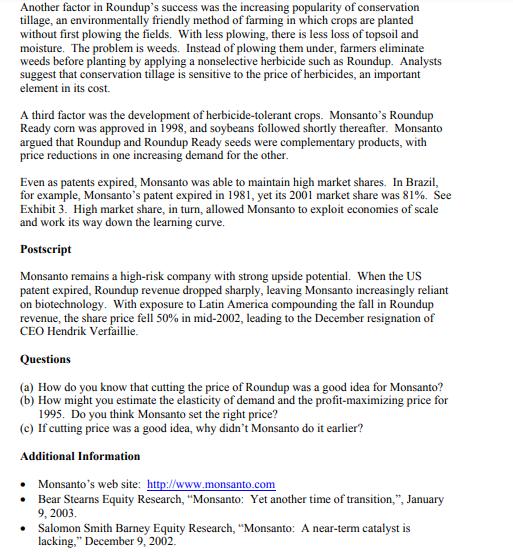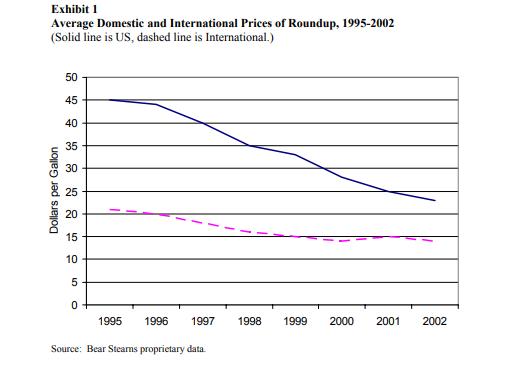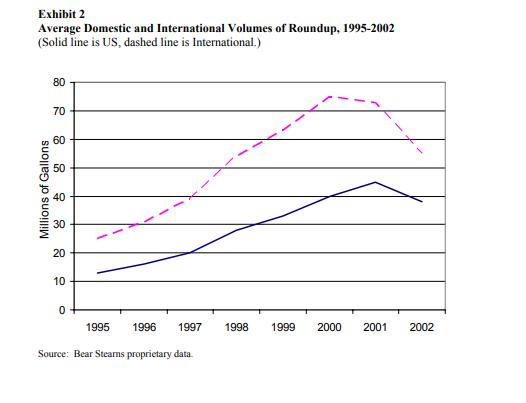Answered step by step
Verified Expert Solution
Question
1 Approved Answer
When Pharmacia merged with troubled Monsanto in 1999, investors complained that Monsanto would weigh down Pharmacia's profits. Pharmacia apparently felt the same way, keeping





When Pharmacia merged with troubled Monsanto in 1999, investors complained that Monsanto would weigh down Pharmacia's profits. Pharmacia apparently felt the same way, keeping Monsanto's drug unit, Searle, but selling 15% of the remaining company as a precursor to dumping it altogether. Investors couldn't have been more wrong. Between Monsanto's IPO in October 2000 and August 2001, its share price jumped 80%. Shares of Pharmacia (which still owns 85 percent of Monsanto) fell almost 20%. How did Monsanto do it? Monsanto St Louis-based Monsanto was founded in 1901 to manufacture Saccharine. It soon added vanilla, phenol, and aspirin. By 1990, Monsanto was a large diversified chemical company producing nylon, plastics, films, hydraulic fluids, aspartame (Nutrasweet), and pharmaceuticals (the last two through its Searle unit, acquired in 1985). In the mid-1990s, Monsanto positioned itself as a high-growth "life sciences" company, focusing on agriculture, food ingredients, and pharmaceuticals. When Robert Shapiro took over as CEO in 1995, he pursued a vision of using cutting-edge science to generate profits, raise living standards in developing countries, and produce a cleaner environment. He added seed and genomics companies and spun off the basic chemicals business. The strategy was to use the revenue generated by its hugely profitable Roundup to finance research and development. Uncertainties associated with biotechnology research and consumer fears of genetically modified foods, particularly in Europe, led to the departure of Shapiro and the merger with Pharmacia. Roundup Monsanto's leading product was Roundup, the trademarked name of glyphosate, a chemical herbicide developed and patented by Monsanto in the 1970s. Roundup is referred to as a nonselective herbicide, meaning it kills most plants. In the late 1990s, it became the best-selling agricultural chemical of all time and an enormously profitable product for Monsanto. This success was the result of several factors. One was a conscious strategy to reduce price in the US, where patent protection gave it an effective monopoly until September 2000. (Prices were lower outside the US, where patents expired earlier.) Between 1995 and 2000, Monsanto reduced the price by an average of 9% a year. When volume increased by an average of 22% a year, revenue and profits Another factor in Roundup's success was the increasing popularity of conservation tillage, an environmentally friendly method of farming in which crops are planted without first plowing the fields. With less plowing, there is less loss of topsoil and moisture. The problem is weeds. Instead of plowing them under, farmers eliminate weeds before planting by applying a nonselective herbicide such as Roundup. Analysts suggest that conservation tillage is sensitive to the price of herbicides, an important element in its cost. A third factor was the development of herbicide-tolerant crops. Monsanto's Roundup Ready corn was approved in 1998, and soybeans followed shortly thereafter. Monsanto argued that Roundup and Roundup Ready seeds were complementary products, with price reductions in one increasing demand for the other. Even as patents expired, Monsanto was able to maintain high market shares. In Brazil, for example, Monsanto's patent expired in 1981, yet its 2001 market share was 81%. See Exhibit 3. High market share, in turn, allowed Monsanto to exploit economies of scale and work its way down the learning curve. Postscript Monsanto remains a high-risk company with strong upside potential. When the US patent expired, Roundup revenue dropped sharply, leaving Monsanto increasingly reliant on biotechnology. With exposure to Latin America compounding the fall in Roundup revenue, the share price fell 50% in mid-2002, leading to the December resignation of CEO Hendrik Verfaillie. Questions (a) How do you know that cutting the price of Roundup was a good idea for Monsanto? (b) How might you estimate the elasticity of demand and the profit-maximizing price for 1995. Do you think Monsanto set the right price? (c) If cutting price was a good idea, why didn't Monsanto do it earlier? Additional Information Monsanto's web site: http://www.monsanto.com Bear Stearns Equity Research, "Monsanto: Yet another time of transition,", January 9, 2003. Salomon Smith Barney Equity Research, "Monsanto: A near-term catalyst is lacking," December 9, 2002. Exhibit 1 Average Domestic and International Prices of Roundup, 1995-2002 (Solid line is US, dashed line is International.) Dollars per Gallon 50 45 40 35 30 25 20 15 10 51 0 1995 1996 1997 Source: Bear Stearns proprietary data. 1998 1999 2000 2001 2002 Exhibit 2 Average Domestic and International Volumes of Roundup, 1995-2002 (Solid line is US, dashed line is International.) Millions of Gallons 80 70 60 30 20 10 0 1995 1996 Source: Bear Stearns proprietary data. 1997 1998 1999 2000 2001 2002 Exhibit 3 National Market Shares After Patent Expiration Country Argentina Australia Brazil Canada France United States Source: Salomon Smith Barney. Patent Expiration 1984 1988 1983 1990 1991 2000 2001 Market Share 75% 91% 82% 95% 85% 98%
Step by Step Solution
★★★★★
3.43 Rating (150 Votes )
There are 3 Steps involved in it
Step: 1
a Price reduction was a good idea because profits extremely increased exploded as stated in the ...
Get Instant Access to Expert-Tailored Solutions
See step-by-step solutions with expert insights and AI powered tools for academic success
Step: 2

Step: 3

Ace Your Homework with AI
Get the answers you need in no time with our AI-driven, step-by-step assistance
Get Started


